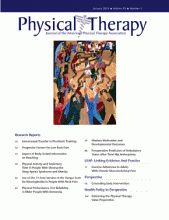Abstract
Background Physical performance tests are important for assessing the effect of physical activity interventions in older people with dementia, but their psychometric properties have not been systematically established within this specific population.
Objective The purpose of this study was to determine the relative and absolute test-retest reliability of the 6-m walk test, the Figure-of-Eight Walk Test (F8W), the Timed “Up & Go” Test (TUG), the Frailty and Injuries: Cooperative Studies of Intervention Techniques–4 (FICSIT–4) Balance Test, the Chair Rise Test (CRT), and the Jamar dynamometer. These tests are used to assess gait speed, dynamic balance, functional mobility, static balance, lower-limb strength, and grip strength, respectively.
Design This investigation was a prospective, nonexperimental study.
Methods Older people with dementia (n=58, age range=70–92 years) performed each test at baseline and again after 1 week. Intraclass correlation coefficients (ICC), standard error of measurement (SEM), minimal detectable change (MDC), and log-transferred limits of agreement of Bland-Altman plots were calculated.
Results The relative reliability of the F8W, TUG, and Jamar dynamometer was excellent (ICC=.90–.95) and good for the 6-m walk test, FICSIT–4, and CRT (ICC=.79–.86). The SEMs and MDCs were large for all tests. The absolute reliability of the TUG and CRT was significantly influenced by the level of cognitive functioning (as assessed with the Mini-Mental State Examination [MMSE]).
Limitations The specific etiology of dementia was not obtained.
Conclusions The physical performance tests evaluated are useful for detecting differences in performance between older people with mild to moderate dementia and, therefore, are suitable for cross-sectional or controlled intervention studies. They appear less suitable to monitor clinically relevant intra-individual performance changes. Future studies should focus on the development of more sensitive tests and the identification of criteria for clinically relevant changes in this rapidly growing population.
Footnotes
All authors provided concept/idea/research design and writing. Mr Blankevoort provided data collection. Dr Scherder provided data analysis. The authors thank all of the students, participants, and institutions for their cooperation.
The research was funded by the University Medical Center Groningen.
- Received May 20, 2011.
- Accepted September 4, 2012.












